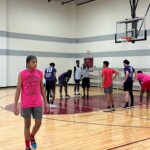Basketball tournaments can serve as more than just sporting events. They can be powerful catalysts for positive change, particularly for at-risk youth and their communities. MVP is proud to hold these tournaments and days of play for our most precious gift, our youth. Contact us today to get involved!
Impact on At-Risk Youth
-
-
Provides a Safe Outlet: Basketball tournaments offer a safe and structured environment for at-risk youth to engage in physical activity and competition. This can help them stay away from negative influences and harmful activities.
-
Fosters Teamwork and Cooperation: Basketball is a team sport that emphasizes collaboration, communication, and mutual respect. These skills are crucial for success in life and can help at-risk youth develop positive relationships.
-
Boosts Self-Esteem: Participating in a tournament can boost self-esteem and confidence, especially for youth who may face challenges in other areas of their lives.
-
Educational Opportunities: Tournaments can be combined with educational workshops or programs, providing at-risk youth with opportunities for academic growth and development.
-
Mentorship and Guidance: Coaches and mentors can provide guidance and support, helping at-risk youth navigate challenges and make positive choices.
-
Impact on the Community
-
Unites the Community: Basketball tournaments can bring people together from different backgrounds and neighborhoods, fostering a sense of unity and belonging.
-
Economic Benefits: Tournaments can attract visitors and generate revenue for local businesses, boosting the local economy.
-
Positive Role Models: Successful athletes can serve as positive role models for young people, inspiring them to strive for greatness.
-
Community Development: Tournaments can be used to raise funds for community projects or charitable causes.
-
The Power of Sports for Youth Development
Sports play a crucial role in the lives of young people, offering numerous benefits beyond physical fitness. Here’s how sports can positively impact youth development:
Physical Health
- Improved fitness: Regular physical activity helps children develop strong bodies and maintain healthy weight.
- Reduced risk of diseases: Participation in sports can lower the risk of obesity, heart disease, and diabetes.
- Enhanced coordination: Sports help develop fine and gross motor skills.
Mental and Emotional Health
- Boosted self-esteem: Success in sports can boost self-confidence and self-worth.
- Stress reduction: Physical activity is an effective way to manage stress and anxiety.
- Improved mood: Exercise releases endorphins, which can elevate mood and reduce depression symptoms.
- Resilience: Overcoming challenges in sports can build resilience and perseverance.
Social Skills
- Teamwork: Sports teach children the importance of cooperation and collaboration.
- Leadership: Opportunities to lead teams or take on leadership roles.
- Communication: Effective communication is essential for team success.
- Sportsmanship: Developing respect, fairness, and good sportsmanship.
Life Skills
- Goal setting: Setting and achieving goals in sports can translate to other areas of life.
- Time management: Balancing sports with schoolwork and other commitments.
- Discipline: Adhering to rules, practices, and training schedules.
- Problem-solving: Developing strategies to overcome challenges and setbacks.
Community Involvement
- Sense of belonging: Participating in sports can foster a sense of community and belonging.
- Positive role models: Coaches and mentors can provide guidance and support.
- Opportunities for service: Many sports programs involve community service initiatives.
By participating in sports, young people can develop valuable skills, build confidence, and create lifelong memories. It’s a powerful tool for positive youth development.








[…] For more information, check out this post on our basketball tournaments. […]